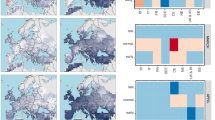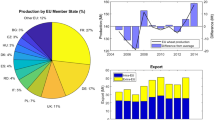Abstract
The real-time non-invasive determination of crop biomass and yield prediction is one of the major challenges in agriculture. An interesting approach lies in using process-based crop yield models in combination with real-time monitoring of the input climatic data of these models, but unknown future weather remains the main obstacle to reliable yield prediction. Since accurate weather forecasts can be made only a short time in advance, much information can be derived from analyzing past weather data. This paper presents a methodology that addresses the problem of unknown future weather by using a daily mean climatic database, based exclusively on available past measurements. It involves building climate matrix ensembles, combining different time ranges of projected mean climate data and real measured weather data originating from the historical database or from real-time measurements performed in the field. Used as an input for the STICS crop model, the datasets thus computed were used to perform statistical within-season biomass and yield prediction. This work demonstrated that a reliable predictive delay of 3–4 weeks could be obtained. In combination with a local micrometeorological station that monitors climate data in real-time, the approach also enabled us to (i) predict potential yield at the local level, (ii) detect stress occurrence and (iii) quantify yield loss (or gain) drawing on real monitored climatic conditions of the previous few days.






Similar content being viewed by others
References
Basso, B., Bertocco, M., Sartori, L., & Martin, E. C. (2007). Analyzing the effects of climate variability on spatial pattern of yield in a maize–wheat–soybean rotation. European Journal of Agronomy, 26(2), 82–91. doi:10.1016/j.eja.2006.08.008.
Basso, B., Cammarano, D., Troccoli, A., Chen, D., & Ritchie, J. T. (2010). Long-term wheat response to nitrogen in a rainfed mediterranean environment: Field data and simulation analysis. European Journal of Agronomy, 33(2), 132–138. doi:10.1016/j.eja.2010.04.004.
Basso, B., Fiorentino, C., Cammarano, D., Cafiero, G., & Dardanelli, J. (2012). Analysis of rainfall distribution on spatial and temporal patterns of wheat yield in Mediterranean environment. European Journal of Agronomy, 41, 52–65. doi:10.1016/j.eja.2012.03.007.
Basso, B., & Ritchie, J. T. (2005). Impact of compost, manure and inorganic fertilizer on nitrate leaching and yield for a 6-year maize-alfalfa rotation in Michigan. Agriculture, Ecosystems & Environment, 108, 241–329.
Basso, B., Ritchie, J. T., Cammarano, D., & Sartori, L. (2011). A strategic and tactical management approach to select optimal N fertilizer rates for wheat in a spatially variable field. European Journal of Agronomy, 35(4), 215–222. doi:10.1016/j.eja.2011.06.004.
Bellocchi, G., Rivington, M., Donatelli, M., & Matthews, K. (2010). Validation of biophysical models: Issues and methodologies. Agronomy for Sustainable Development, 30(1), 109–130.
Brisson, N., Gary, C., Justes, E., Roche, R., Mary, B., Ripoche, D., et al. (2003). An overview of the crop model STICS. European Journal of Agronomy, 18(3–4), 309–332. doi:10.1016/s1161-0301(02)00110-7.
Brisson, N., Launay, M., Mary, B., & Beaudoin, N. (2009). Conceptual basis, formalisations and parameterization of the STICS crop model. Versailles: Editions Quae Collection Update Sciences and technologies.
Brisson, N., Mary, B., Ripoche, D., Jeuffroy, M. H., Ruget, F., Nicoullaud, B., et al. (1998). STICS: A generic model for the simulation of crops and their water and nitrogen balances. I. Theory and parameterization applied to wheat and corn. Agronomie, 18(5–6), 311–346.
Campbell, G. S., & Norman, J. M. (1989). The description and measurement of plant canopy structure. In G. Russell, B. Marshall, & P. G. Jarvis (Eds.), Plant canopies: Their growth form and function. Cambridge: Cambridge University Press.
Cantelaube, P., & Terres, J. M. (2003). Use of seasonal forecasts on crop yield modelling. Publication of the European Commission, EUR 20996 EN.
Cantelaube, P., & Terres, J. M. (2005). Seasonal weather forecasts for crop yield modelling in Europe. Tellus, 57(3), 476–487. doi:10.1111/j.1600-0870.2005.00125.x.
Challinor, A. J., Slingo, J. M., Wheeler, T. R., & Doblas-Reyes, F. J. (2005). Probabilistic simulations of crop yield over Western India using the DEMETER seasonal hindcast ensembles. Tellus, 57(3), 498–512. doi:10.1111/j.1600-0870.2005.00126.x.
Dumont, B., Leemans, V., Mansouri, M., Bodson, B., Destain, J.-P., & Destain, M.-F. (2013). Parameter identification of the STICS crop model, with an accelerated formal MCMC approach. Environmental Modelling and Software, 54, 121–135.
Ewert, F., van Ittersum, M. K., Heckelei, T., Therond, O., Bezlepkina, I., & Andersen, E. (2011). Scale changes and model linking methods for integrated assessment of agri-environmental systems. Agriculture, Ecosystems & Environment, 142(1–2), 6–17. doi:10.1016/j.agee.2011.05.016.
Hansen, S., Jensen, H. E., Nielsen, N. E., & Svendsen, H. (1990). Daisy, a soil plant system model. Danish simulation model for transformation and transport of energy and matter in the soil plant atmosphere system (p. 369). Copenhagen: The National Agency for Environment Protection.
Hewitt, C. D. (2004). Ensembles-based predictions of climate changes and their impacts. Eos, Transactions American Geophysical Union, 85(52), 566. doi:10.1029/2004eo520005.
Jamieson, P. D., Semenov, M. A., Brooking, I. R., & Francis, G. S. (1998). Sirius: A mechanistic model of wheat response to environmental variation. European Journal of Agronomy, 8(3–4), 161–179. doi:10.1016/s1161-0301(98)00020-3.
Lawless, C., & Semenov, M. A. (2005). Assessing lead-time for predicting wheat growth using a crop simulation model. Agricultural and Forest Meteorology, 135(1–4), 302–313. doi:10.1016/j.agrformet.2006.01.002.
Mansouri, M., Dumont, B., & Destain, M.-F. (2013). Modeling and prediction of nonlinear environmental system using Bayesian methods. Computers and Electronics in Agriculture, 92, 16–31.
Mavromatis, T., & Hansen, J. W. (2001). Interannual variability characteristics and simulated crop response of four stochastic weather generators. Agricultural and Forest Meteorology, 109(4), 283–296. doi:10.1016/s0168-1923(01)00272-6.
Mavromatis, T., & Jones, P. D. (1998). Comparison of climate change scenario construction methodologies for impact assessment studies. Agricultural and Forest Meteorology, 91(1–2), 51–67. doi:10.1016/s0168-1923(98)00063-x.
McBratney, A., Whelan, B., Ancev, T., & Bouma, J. (2005). Future directions of precision agriculture. Precision Agriculture, 6(1), 7–23. doi:10.1007/s11119-005-0681-8.
Naud, C., Makowski, D., & Jeuffroy, M.-H. (2008). Is it useful to combine measurements taken during the growing season with a dynamic model to predict the nitrogen status of winter wheat? European Journal of Agronomy, 28, 291–300.
Nonhebel, S. (1994a). The effects of use of average instead of daily weather data in crop growth simulation models. Agricultural Systems, 44(4), 377–396. doi:10.1016/0308-521x(94)90194-k.
Nonhebel, S. (1994b). Inaccuracies in weather data and their effects on crop growth simulation results. Climate Research, 4, 47–60.
Palmer, T. N., Doblas-Reyes, F. J., Hagedorn, R., Alessandri, A., Gualdi, S., Andersen, U., et al. (2004). Development of a European multi-model ensemble system for seasonal to interannual prediction (DEMETER). Bulletin of the American Meteorological Society, 85(6), 853–872. doi:10.1175/bams-85-6-853.
Palmer, T. N., Doblas-Reyes, F. J., Hagedorn, R., & Weisheimer, A. (2005). Probabilistic prediction of climate using multi-model ensembles: From basics to applications. Philosophical Transactions of the Royal Society B: Biological Sciences, 360(1463), 1991–1998.
Palosuo, T., Kersebaum, K. C., Angulo, C., Hlavinka, P., Moriondo, M., Olesen, J. E., et al. (2011). Simulation of winter wheat yield and its variability in different climates of Europe: A comparison of eight crop growth models. European Journal of Agronomy, 35(3), 103–114.
Porter, J. R., & Semenov, M. A. (1999). Climate variability and crop yields in Europe. Nature, 400(6746), 724.
Porter, J. R., & Semenov, M. A. (2005). Crop responses to climatic variation. Philosophical Transactions of the Royal Society B: Biological Sciences, 360(1463), 2021–2035.
Racsko, P., Szeidl, L., & Semenov, M. (1991). A serial approach to local stochastic weather models. Ecological Modelling, 57(1–2), 27–41. doi:10.1016/0304-3800(91)90053-4.
Riha, S. J., Wilks, D. S., & Simoens, P. (1996). Impact of temperature and precipitation variability on crop model predictions. Climatic Change, 32(3), 293–311. doi:10.1007/bf00142466.
Ritchie, J. T., & Otter, S. (1984). Description and performance of CERES-wheat, a user oriented wheat yield model (pp. 159–177). Temple: USDA-ARS-SR Grassland Soil and Water Research Laboratory.
Semenov, M. A. (2008). Simulation of weather extreme events by stochastic weather generator. Climate Research, 35, 203–212.
Semenov, M. A., & Barrow, E. M. (1997). Use of a stochastic weather generator in the development of climate change scenarios. Climatic Change, 35(4), 397–414. doi:10.1023/a:1005342632279.
Semenov, M. A., & Doblas-Reyes, F. J. (2007). Utility of dynamical seasonal forecasts in predicting crop yield. Climate Research, 34(1), 71–81.
Semenov, M., & Porter, J. (1995). Climatic variability and the modelling of crop yields. Agricultural and Forest Meteorology, 73(3–4), 265–283. doi:10.1016/0168-1923(94)05078-k.
Singh, U., & Thornton, P. K. (1992). Using crop models for sustainability and environmental quality assessment. Outlook on agriculture, 21(3), 33–39.
Singh, A. K., Tripathy, R., & Chopra, U. K. (2008). Evaluation of CERES-Wheat and CropSyst models for water–nitrogen interactions in wheat crop. Agricultural Water Manage, 95, 776–786.
Tey, Y., & Brindal, M. (2012). Factors influencing the adoption of precision agricultural technologies: A review for policy implications. Precision Agriculture, 13(6), 713–730. doi:10.1007/s11119-012-9273-6.
Van Diepen, C. A., Wolf, J., Van Keulen, H., & Rappoldt, C. (1989). WOFOST: A simulation model of crop production. Soil Use Manage, 5, 16–24.
Vrugt, J. A., Braak, C. J. F. T., Diks, C. G. H., Robinson, B. A., Hyman, J. M., & Higdon, D. (2009). Accelerating Markov chain Monte Carlo simulation by differential evolution with self-adaptive randomized subspace sampling. International Journal of Nonlinear Sciences and Numerical Simulation, 10(3), 273–290.
William, J. R., Jones, C. A., Kiniry, J. R., & Spanel, D. A. (1989). The EPIC crop growth model. Transactions of the ASAE, 32, 497–511.
Acknowledgments
The authors thank the Service Public de Wallonie, Direction Générale Opérationnelle de l’Agriculture, des Ressources naturelles et de l’Environnement (SPW-DGO3) for its financial support for the project entitled ‘Suivi en temps réel de l’environnement d’une parcelle agricole par un réseau de microcapteurs en vue d’optimiser l’apport en engrais azotés’. The authors thank also the OptimiSTICS team that allowed them to use the Matlab running code of the STICS model. They are very grateful to CRA-w, especially the Department ‘Agriculture et milieu naturel’, for the Ernage station climate database and to staff in the ULg- GxABT Geopedological Unit for their soil analyses. Finally, they wish to thank the two anonymous reviewers for their helpful comments.
Author information
Authors and Affiliations
Corresponding author
Rights and permissions
About this article
Cite this article
Dumont, B., Leemans, V., Ferrandis, S. et al. Assessing the potential of an algorithm based on mean climatic data to predict wheat yield. Precision Agric 15, 255–272 (2014). https://doi.org/10.1007/s11119-014-9346-9
Published:
Issue Date:
DOI: https://doi.org/10.1007/s11119-014-9346-9




